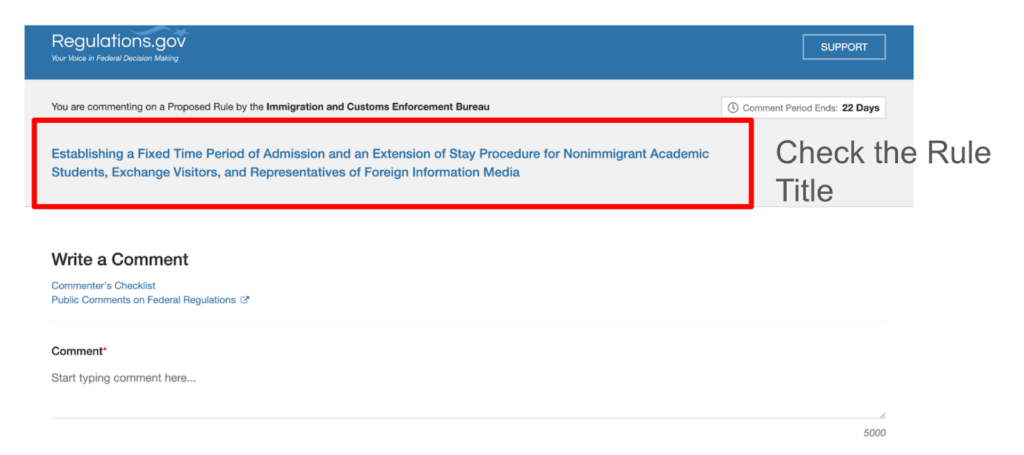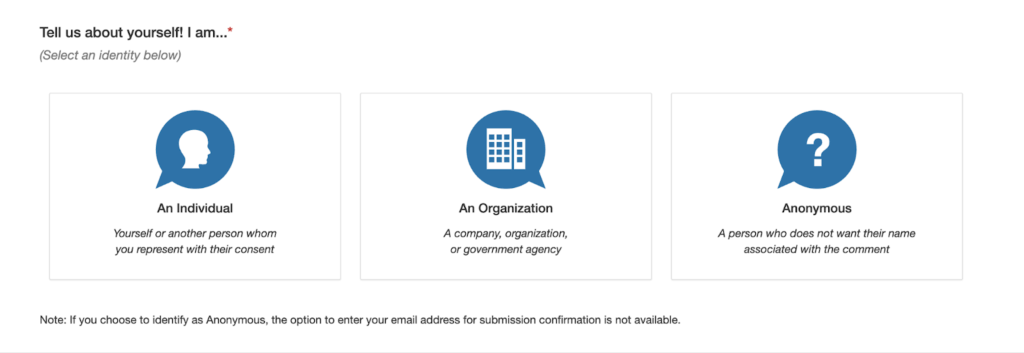A similar rule was proposed in 2020 and successfully stopped after over 30,000 public comments. Every voice truly matters. We sincerely hope you can submit a public comment letter as an individual (can be done anonymously) opposing the rule on the federal portal by Sep 29, 2025, at 11:59 PM EDT.
How to submit your comments?
Comments can be submitted on this website: https://www.regulations.gov/commenton/ICEB-2025-0001-0001

You can submit your comment as an individual or anonymously:

How to write a policy comment?
According to the recommendations on the government’s website, an effective policy comment should include the following sections:
- an introduction where you explain why you are interested in the regulation and highlight any experience with the subject of the rule that may distinguish your comment;
- a background section where you clearly identify the relevant part of the regulation you are commenting on;
- analysis that lays out your argument and evidence (including with clear citations to any helpful research)—for example, how the action impacts you and what you care about; whether the agency anticipated or estimated these impacts correctly; any unintended consequences of this approach that the agency did not consider; and what additional details from the agency would help you better understand the action;
- recommendations describing your suggestions to the agency and identifying specific changes you would advise—for example, providing a different way of addressing the problem the agency may not have considered; and
- a conclusion which recaps your main argument and lists your recommendations again
Below is an outline for a policy comment, including specific reference arguments and supporting data. Please supplement it with your own background and experiences following the framework described above. Be sure to write the comment in your own words as the Office of Management and Budget may consider multiple comments with the same text as one comment.
- Introduction
- Explain why you are interested in the regulation and highlight any experience with the subject of the rule that may distinguish your comment
- Incorporate human impact stories: Include personal testimonies and community perspectives—especially from U.S. students, faculty, employers, and institutions—to demonstrate the real-life consequences beyond the international student community.
- State your position clearly: DHS should not implement the proposed changes to 8 CFR 214.2(f)(5)(i) and preserve the current Duration of Status (D/S) framework.
- Background and analysis
- Regarding the proposed change to remove duration of stay (D/S) to limit the admittance period to 4 years or fewer
- Virtually every doctoral program takes longer than 4 years. The Survey of Earned Doctorates from the National Science Foundation in 2024 estimates the average doctoral program takes 5.7 years, meaning that all doctoral international students would have to file an I-539 extension of stay form at least once. In 2023, there were 206,433 international students pursuing PhDs, or 15.3% of all international students at the time.
- Currently, the USCIS processing times tool estimates that an I-539 extension review for F, J, and M visas takes 3.5 months, unless applicants pay a premium price of $1,965. Almost every single doctoral student needing to file this form would significantly lengthen the wait time
- All of those students would have to submit extension requests for each year after the 4 year maximum, which would impose unnecessary costs and strain on USCIS and the broader immigration system. According to USCIS’s own data, pending cases are already at an all-time high in Q2 FY 2025, with a record 11.3 million pending cases.
- Each extension application carries the risk of denial, even for something as small as a clerical error; in 2022, 10% of USCIS’s petition rejections were due to clerical errors. A student could possibly spend 4+ years working on their degree, only to not be able to continue.
- Designated School Officials (DSOs) would have to undergo additional training and adaptation, estimated to cost $93.3 million across the sector in year one.
- The additional bureaucratic complication and financial cost disrupts academic studies and discourages international students from applying and studying in the US.
- F-1 visas are not just limited to higher education: in 2024, there were over 54,000 international students in K-12 schools.
- Regarding the proposal to limit “school transfer and change in educational objectives”
- Prohibiting graduate F-1 students from changing educational objectives or transferring from within the United States severely limits graduate-level study
- Overall, the proposal undermines America’s ability to attract global talent, weakens technological innovation, slows economic growth, and harms national interests.
- In 2024-25, international students contributed an estimated $46 billion to the US economy and supported 400,000 jobs, but this year, NAFSA is estimating that newly implemented visa bans and regulations affecting international students will cost the economy $7 billion and 60,000 jobs.
- International students are an important source of talent in critical fields. Recent data from the Association of American Universities shows that 73% of STEM international graduates continue to live and work in the US several years after graduation, providing vital scientific, technological, and economic benefits to the US. A 2024 report from the National Science Board estimates that foreign-born individuals make up 43% of doctorate-level scientists and engineers in the US.
- The proposed changes jeopardize U.S. leadership in global higher education. The US higher education system hosts X students, X of whom are international.
- The rule makes it harder for U.S. institutions, research labs, academic teams, and entrepreneurs to recruit and retain qualified workers.
- Many of the proposed changes faced widespread opposition in 2020, amassing over 32,000 comments, 99% of which were opposed.
- The Risks to the Integrity of the F, J, and I Nonimmigrant Classifications, as outlined to support the proposal, are not enough to justify such a drastic change in policy which would affect every international student in the US.
- Under risks within the F classification, DHS alleges that as of 2025, 2,100 international students have been on F-1 status for 15 years or more, have entered consecutive educational programs or transferred schools to maintain this status, and could therefore be abusing the system to stay in the US indefinitely. F-1 visas are issued for students from K-12 all the way through doctoral educational programs. A student who began studying in the US during high school, who is now finishing a doctoral degree, would be included in this list of 2,100, and viewed as suspicious despite fully complying with the laws and intent of the visa policy. Furthermore, between 2010-2024, the US has issued 5,817,019 F-1 visas, meaning that these potential cases of fraud make up at most 0.036% of all F-1 issuances.
- Under risks within the J classification, the proposal cites several examples of J-1 holders who were charged with serious counts of fraud or intellectual property theft, who are all Chinese nationals. A program which investigated Chinese Communist Party affiliated espionage in academia that officially ran from 2019-2022 investigated hundreds of academics for fraud and espionage, but by 2021, less than 30 percent of cases resulted in convictions or guilty pleas — a staggering discrepancy from the overall federal rate, which sits above 90 percent. The US admits hundreds of thousands of Chinese students every year (329,541 in 2024) who are already subject to stringent restrictions during visa application. Although national security concerns are valid, these extremely rare cases should not justify a proposed rule change that would affect millions of international students.
- Offer constructive alternatives: Recommend maintaining the D/S framework, preserving the F-1 grace period, and ensuring that immigration policy remains stable and predictable.
- Regarding the proposed change to remove duration of stay (D/S) to limit the admittance period to 4 years or fewer
References
- Yale OISS explainer on what is d/s: https://oiss.yale.edu/news/dhs-proposes-to-replace-duration-of-status-with-fixed-periods-of-stay-for-f-j-nonimmigrants
- NAFSA’s detailed analysis of all changes: https://www.nafsa.org/regulatory-information/trump-vance-administration-proposal-replace-duration-status
- National Center for Science and Engineering Statistics (NCSES). 2025. Doctorate Recipients from U.S. Universities: 2024 Data Tables. NSF 25-349. Alexandria, VA: U.S. National Science Foundation. Available at https://ncses.nsf.gov/surveys/earned-doctorates/2024.
- U.S. Immigrations and Customs Enforcement (ICE). 2025. Student and Exchange Visitor Program (SEVP) 2024 SEVIS by the Numbers Report. Available at https://www.ice.gov/doclib/sevis/btn/25_0605_2024-sevis-btn.pdf
- “Fee Schedule.” USCIS, 29 Aug. 2025, https://www.uscis.gov/g-1055?topic_id=97333.
- Wachs, Rayna. “USCIS Q2 Data: Backlogs Hit Record High as EB-1A Growth Slows, Processing Times Surge.” Boundless, 23 July 2025, https://www.boundless.com/blog/uscis-q2-fy2025-data/
- U.S. Department of State — Bureau of Consular Affairs. 2014. Report of the Visa Office 2014: Table XVI(B) Nonimmigrant Visas Issued by Classification (Including Crewlist Visas and Border Crossing Cards) Fiscal Years 2010-2014. Available at https://travel.state.gov/content/dam/visas/Statistics/AnnualReports/FY2014AnnualReport/FY14AnnualReport-TableXVIB.pdf
- U.S. Department of State — Bureau of Consular Affairs. 2019. Report of the Visa Office 2019: Table XVI(B) Nonimmigrant Visas Issued by Classification (Including Crewlist Visas and Border Crossing Cards) Fiscal Years 2015-2019. Available at https://travel.state.gov/content/dam/visas/Statistics/AnnualReports/FY2019AnnualReport/FY19AnnualReport-TableXVI-B.pdf
- U.S. Department of State — Bureau of Consular Affairs. 2024. Report of the Visa Office 2024: Table XV(B) Nonimmigrant Visas Issued by Classification (Including Crewlist Visas and Border Crossing Cards) Fiscal Years 2020-2024. Available at https://travel.state.gov/content/dam/visas/Statistics/AnnualReports/FY2024AnnualReport/Table%20XVB.pdf
- Guo, Eileen, et al. “The US Crackdown on Chinese Economic Espionage Is a Mess. We Have the Data to Show It.” MIT Technology Review, 2 Dec. 2021, https://www.technologyreview.com/2021/12/02/1040656/china-initative-us-justice-department/.
- Gramlich, John. “Only 2% of Federal Criminal Defendants Go to Trial, and Most Who Do Are Found Guilty.” Pew Research Center, 11 June 2019, https://www.pewresearch.org/short-reads/2019/06/11/only-2-of-federal-criminal-defendants-go-to-trial-and-most-who-do-are-found-guilty/
- U.S. Immigrations and Customs Enforcement (ICE). 2025. Student and Exchange Visitor Program (SEVP) 2024 SEVIS by the Numbers Report. Available at https://www.ice.gov/doclib/sevis/btn/25_0605_2024-sevis-btn.pdf.
- Proclamation No. 10043, 85 FR 34353 (2020). https://www.federalregister.gov/documents/2020/06/04/2020-12217/suspension-of-entry-as-nonimmigrants-of-certain-students-and-researchers-from-the-peoples-republic
- “U.S. Economy Could Suffer a $7 Billion Loss from Precipitous Drop in International Students.” NAFSA, 29 July 2025, https://www.nafsa.org/about/about-nafsa/us-economy-could-suffer-7-billion-loss-precipitous-drop-international-students
- Jauregui-Volpe, Marcelo. “New Data Show U.S. Retains Significant Share of Foreign Science and Engineering Talent upon Graduation.” Association of American Universities (AAU), 18 Apr. 2025, https://www.aau.edu/newsroom/leading-research-universities-report/new-data-show-us-retains-significant-share-foreign
- Jauregui-Volpe, Marcelo. “New Data Show U.S. Retains Significant Share of Foreign Science and Engineering Talent upon Graduation.” Association of American Universities (AAU), 18 Apr. 2025, https://www.aau.edu/newsroom/leading-research-universities-report/new-data-show-us-retains-significant-share-foreign
- Anderson, Stuart. NFAP Policy Brief: July 2022: Immigrant Entrepreneurs and U.S. Billion-Dollar Companies. National Foundation for American Policy (NFAP), 2022. https://nfap.com/wp-content/uploads/2022/07/2022-BILLION-DOLLAR-STARTUPS.NFAP-Policy-Brief.2022.pdf
- “Archive: 2020 Trump-Pence Administration Proposal to Replace Duration of Status.” NAFSA, 15 Nov. 2024, https://www.nafsa.org/professional-resources/browse-by-interest/proposal-replace-duration-status
